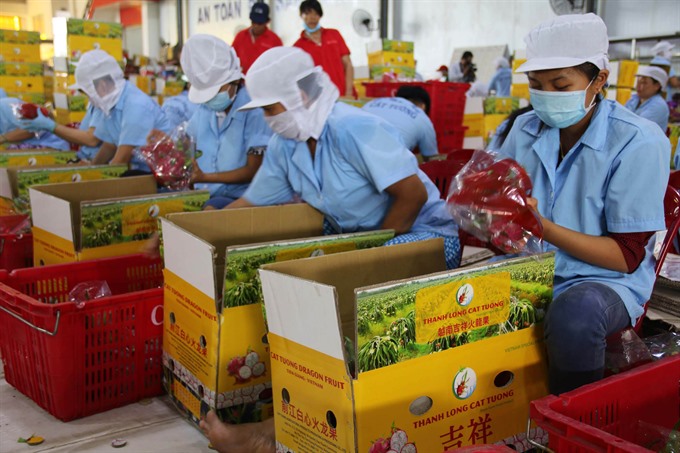 Society
Society

Post-harvest losses not only refer to the quantity of lost crops, but also any reductions in their quality and access to international markets, experts have said.
 |
| Workers pack dragon fruit for export at Cát Tường Agriculture Products Production and Processing Ltd Co in the southern province of Tiền Giang. — VNA/VNS Photo Minh Trí |
HÀ NỘI — Post-harvest losses not only refer to the quantity of lost crops, but also any reduction in their quality and access to international markets, experts have said.
Former head of the Institute of Agricultural Science of Southern Việt Nam, Bùi Chí Bửu, said that post-harvest losses in Việt Nam were significant, but the country had little in the way of post-harvest technology or machinery.
Bửu was quoted by the Thanh Niên (Young People) newspaper as saying that harvesting and post-harvesting technologies in Việt Nam were on the edge of industrial revolution 2.0, implying they showed modest development, except some industrial husbandry models which had recently received good investment.
Bửu said that 70 per cent of Việt Nam’s export fruit and vegetables went to China, most of them fresh and unprocessed.
Few of Việt Nam’s fruit and vegetable exports went to South Korea, Japan, the United States or the European Union because of Việt Nam’s limitations in storing and post-harvest processing, he said.
Việt Nam’s seafood faces similar issues, particularly with ocean tuna. Japan is a big market for this fish and is willing to pay high prices for it. A number of Japanese experts have attempted to assist Vietnamese fishermen in post-harvest processing, but so far, little difference has been made.
According to the Food and Agriculture Organisation of the United Nations (FAO), Việt Nam’s post harvesting losses accounted for 10 per cent of rice production, 10-20 per cent of root and tuber crops, and 10-30 per cent of fruit and vegetables.
In the Mekong Delta region – a major rice bowl for Việt Nam, post-harvest rice losses were more than VNĐ3 trillion (US$132 million) a year, or 10-12 per cent of total rice production.
Bửu said that to reduce post-harvesting losses, it was necessary to call on investors to make further investments in agricultural production.
This means the Government needs to offer incentives to encourage farmers. Additionally, research and study centres should be assisted with post-harvesting related work, he said.
According to the Ministry of Agriculture and Rural Development, between 2011 and the middle of last year, loans worth about VNĐ8.1 trillion ($356.6 million) were offered to mechanise farming activities. The Government spent VNĐ600 billion to subsidise the interest rate for borrowers.
But the financial incentives failed to encourage investors because the interest rates of the preferential loans - 8.55 per cent per year - were still high, Thanh Niên reported.
Nguyễn Quốc Vọng from New South Wales’ Agriculture Department in Australia said that to develop an agricultural product, it was necessary to study all stages of seeding, producing, processing and marketing. Specialised sciences and technologies should be used at each stage, he said.
Dr Arjo Rothuis from Wageningen University and Research Centre in the Netherlands, said that when it came to post harvesting, it was not only about technologies that kept food fresh and delicious, but also extended their expiry dates.
Another new requirement by customers and importers was about energy saving in packaging, storage and transportation, he said, adding that investments in post harvesting and logistics were needed to make farming products reach markets earlier. — VNS




